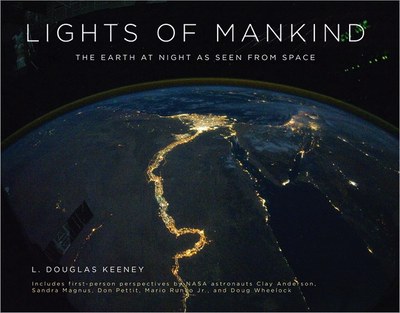Review: Lights of Mankindby Jeff Foust
|
| The cover image reveals how the population of Egypt is concentrated along the Nile River, turning it at night into a river of light winding through a dark desert. |
Images of the Earth at night aren’t that new—the DMSP series of polar-orbiting weather satellites have collected such images for years—but have tended to be of relatively low resolution and quality. However, as L. Douglas Keeney explains in Lights of Mankind, technological advances, including cameras with improved light sensitivity and a tracking mount on the ISS that compensates for the station’s orbital motion, thus permitting longer exposures, astronauts are now able to take much sharper images of the Earth at night, turning what had previously been diffuse blobs of light into intricate structures reflecting each city’s unique geography and history.
Lights of Mankind provides a sampling of some of the best such nighttime imagery from six continents (Antarctica, not surprisingly, is excluded). Many cities are visible in sharp detail, revealing their network of roads and patterns of development, from grids to hubs-and-spokes to more irregular patterns, that are much harder to see during the day. Keeney matches the images with brief captions describing the images and including in many cases capsule histories of those cities. Included in the book are several essays from astronauts who have flown on the ISS, providing their views of what it was like to view, and photograph, the Earth at night.
The bulk of the book, though, is images, not text, and some of those images are stunning. The cover image, for example, reveals how the population of Egypt is concentrated along the Nile River, turning it at night into a river of light winding through a dark desert. Sometimes it’s the absence of light that is the most dramatic, as in images contrasting the bright lights of Seoul and South Korea with the darkness of North Korea.
One aspect of these scenes that Lights of Mankind doesn’t touch upon, unfortunately, is the implications of these scenes for those on the ground. Those bright lights of cities are evidence of light pollution that washes out the night skies for people living in major cities, making only the brightest stars and planets visible. There is a certain irony of people in space taking images of manmade terrestrial constellations whose conditions make it difficult for people on the ground to appreciate the natural beauty of space. That makes the images in this book no less striking, but it should serve as a reminder of what’s lost in exchange for this scenery.
